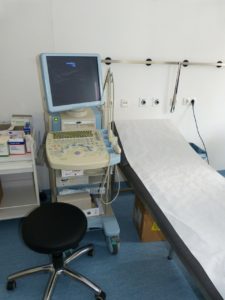The perception on pregnancy has morphed over the past century. It’s no longer anticipated to be a beautiful and natural experience. Rather, prenatal care is treated similar to a medical condition. A grave disease to be dreaded and feared.
It’s imperative that we shift our thoughts from this modern day grotesque perception. Instead educate yourself on how to proactively prevent issues before they arise, and how to make informed choices about prenatal care.
Prenatal Visits
From the time that women find out that they’re pregnant, until the day the baby’s delivered, the healthcare industry necessitates a wide variety of tests and exams.
Everywhere women look, there’s a push for constant and vigilant monitoring. As though a calamity is lurking around every corner.
With this nagging fear, many women find they are unhappy with their pregnancies. For months, they hide their news, even from those closest to them. They push down their excitement. What if they lose the baby? What if a genetic test comes back showing an abnormality?
For many, it’s best to keep an emotional distance from the baby growing inside of them. This creates a sense of loneliness.
What should be a happy moment in their life is instead a house of cards on the verge of collapsing.
On top of that, the exam room’s white with sterilized items all around. They instruct you to sit on a narrow bed which is covered with plastic paper that sticks to your thighs and crinkles with the smallest movement.

The nurse comes in for the routine check of blood pressure and weight gain. Little personality is shown between robotic questioning and writing notes.
Then you’re left alone, with no real idea of when the doctor will be in.
When they do arrive, they stare down at the clipboard in front of them. Either to read up on the nurses notes or check for your name. It gives the impression that you’re a chart and not a person.
At least that’s how it was with my first pregnancy. I felt like a patient on my death bed, and they had no idea what was wrong with me or how to fix it.
Informed Choice in Prenatal Care
For my second pregnancy, I switched from a hospital to a birthing center. The difference in care was staggering.
I felt comfortable and respected. They knew my name without the assistance of a paper in front of their face.
For each step of my prenatal care, I was presented with options. I was given the freedom to choose. Without any judgement on their part.
I can’t stress enough how important informed choice is. Each woman has different views with how they want to go through their prenatal care and delivery. However, making a choice based solely on what your healthcare provider has to say can cause many problems down the road.
Most doctors want what’s best for their patients. Nevertheless, they base their advice and decisions on what they were taught in medical school. Ask them about more natural approaches, and they won’t have much to say.
At times, this isn’t due to lack of knowledge. Rather to hospital policies restraining them.
Hospitals, whether you have a doctor or midwife, have guidelines that must be followed. They have a wide array of questions for the patient to be asked. Yet, their dominate focus is on what their machines tell them about you. They know little about you as a person.
Are the Prenatal Tests Necessary?
Doctors run countless tests as part of the standard prenatal care. They check for STDs, gestational diabetes, Group B Strep (GBS), and offer genetic screenings. The best way to take back control of your maternity care is to properly educate yourself on each of these topics. Without knowledge, you cannot hold any of the power.
Prenatal Blood Tests
Noninvasive blood tests (NIPT) are offered at one of the first few maternity appointments. These are intended to give you a glimpse into any genetic abnormalities in your baby.
Consequently, they have a high probability of giving a false negative. This creates unnecessary stress, and has caused thousands of women to abort healthy babies.
If you’re truly concerned about the possibility of your baby being born with a disability, speak to your doctor about invasive prenatal genetic testing. They hold a much higher probability of correctly diagnosing your child.
Keep in mind that they do carry a small possibility of a false positive or false negative, may cost thousands of dollars, and have a chance of miscarriage.
STDs
Healthcare professionals screen for sexually transmitted diseases during your care. Gonorrhea, chlamydia, HIV, and syphilis are able to be passed to the baby during pregnancy or delivery. This could cause serious problems in the infant.
However, the treatment for these diseases may also cause serious harm to the unborn child. Antibiotics can cause birth defects and even death. Overuse of antibiotics can lead to bacteria growing stronger, and even create resistance to the treatment. (1)
Gestational Diabetes
Between 24 and 28 weeks, women are checked for gestational diabetes. Blood sugar that’s not properly regulated can lead to issues such as an extra large baby and preeclampsia.
However, gestational diabetes can often be controlled by eating healthy foods and exercise. Implement this from the beginning and you can lessen your chances of testing positive.

If you choose alternative birthing locations, midwives allow you other options for GBS testing.
If you would prefer, you can wave the chemical concoction containing glucose. For those who are nervous, and still want to check, you’re able to eat a meal containing certain food categories before your bloods taken.
For my test, I chose to indulge on orange juice, an egg sandwich, and home fries. Instead of feeling lightheaded, nauseous, and shaky, I delighted in my delicious diner breakfast.
Group B Strep
Group B Strep is tested for between 35 and 37 weeks. GBS is an opportunistic bacteria that lives in the rectum, gut, and vagina. However, statistics show that as many as 25 percent of healthy women have this common strain. (3)
There’s a chance that this bacteria could pass on to the baby during delivery. This can be very serious. Fortunately, my midwife informed me that even if I had GBS and the baby contracted it during birth, the chance of a severe reaction was extremely small.
I was given the option to wave the test if that’s what I desired.
You have to weigh the risks. Is it worth being pumped full of antibiotics during labor? Are the treatments reducing GBS infections or are they making matters worse during a global health threat of antibiotic resistance? (4)
Make a Plan
Find a caregiver that treats you as a face, not another body in a long and exhausting line.
It’s important to create not only a birthing plan, but a prenatal plan as well. This allows you to figure out how you would like your maternal care to progress. What you expect to happen before and during labor.
Sharing your views with your healthcare provider may deter them from pushing interventions when they feel the time arises.
You can choose to proceed with the standard prenatal care, or lean more towards the natural side. The natural approach allows women to focus on what they can do to have a healthy pregnancy.
By focusing on the positive aspects of pregnancy, we can begin to de-stigmatize the experience.

The best advice I have for this is to leave behind the hospitals. They are often too busy to provide quality one on one care. Choose midwives who get to know you. Who educate you on how to prevent a disaster instead of waiting expectantly for one.
The Mama Natural Week-By-Week Guide to Pregnancy & Childbirth is an excellent book for those who want more guidance on a natural pregnancy. She explains what foods are best while pregnant, and even provides a few recipes.
With Genevieve, you not only get weekly secrets of what’s going on with your baby, she tells you positions and exercises that is best for the little bundle of joy as well.
Research Your Delivery Location
Even if you choose to have your baby in a hospital, research is still necessary. Who you choose as your healthcare provider shouldn’t be at the top of your list.
While it’s definitely important to have someone you trust for your appointments, it’s likely you will be at the mercy of who’s on call when your big day arrives. And, as with most hospital deliveries, you will primarily be cared for by other hospital staff.
Find an environment that’s supportive and where you feel comfortable. Check on C-section rates, how often they induce, and how many episiotomies they did the previous year. They vary greatly from hospital to hospital.
There’s an extensive list that should be considered. Check out theBump for more in-depth details.
Stand Firm
It’s unfortunate, but maternity care is a “follow the money” type of situation. It’s not in the medical industry’s best interest to guide women along a natural prenatal path. Women must take this task upon themselves.
More often than not, healthcare providers ignore your thoughts and feelings on topics they feel they are better educated in. They have the attitude that they know best. Don’t question them.
It’s time to stand up for what we believe in. Especially if it goes against the modern way of thinking. A shift back to a natural, joyful pregnancy has to happen. For the mental and physical health of women.